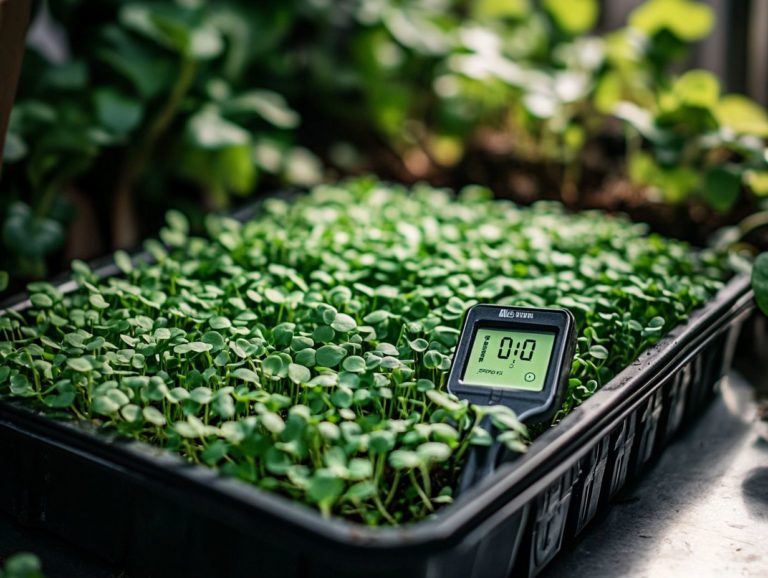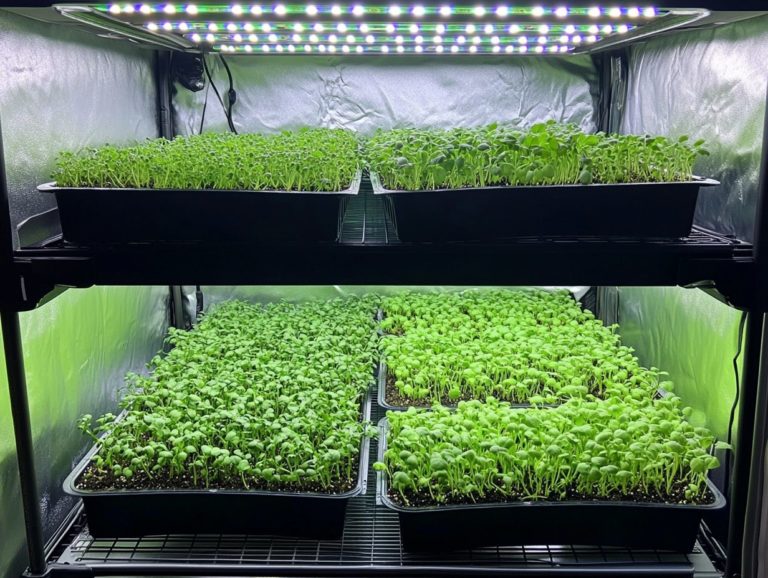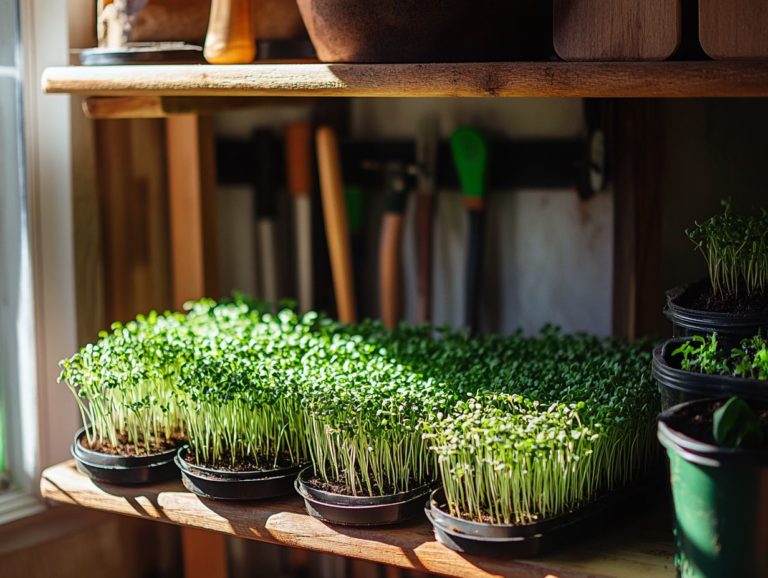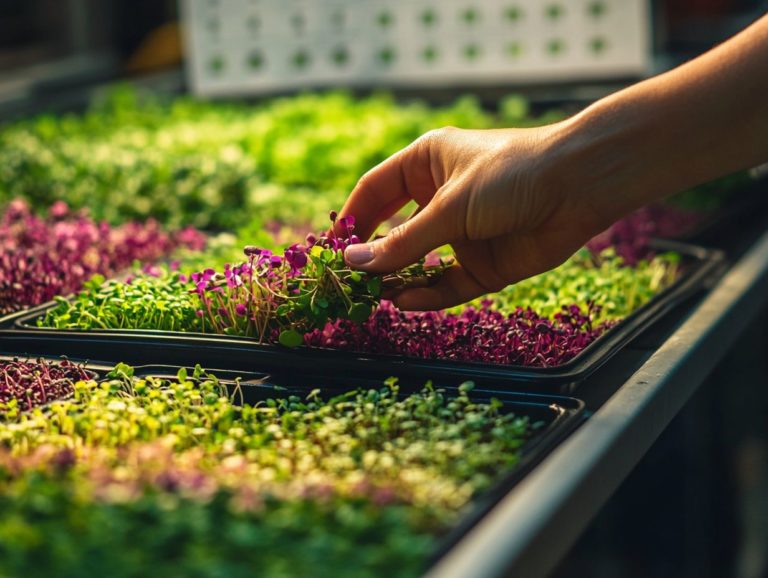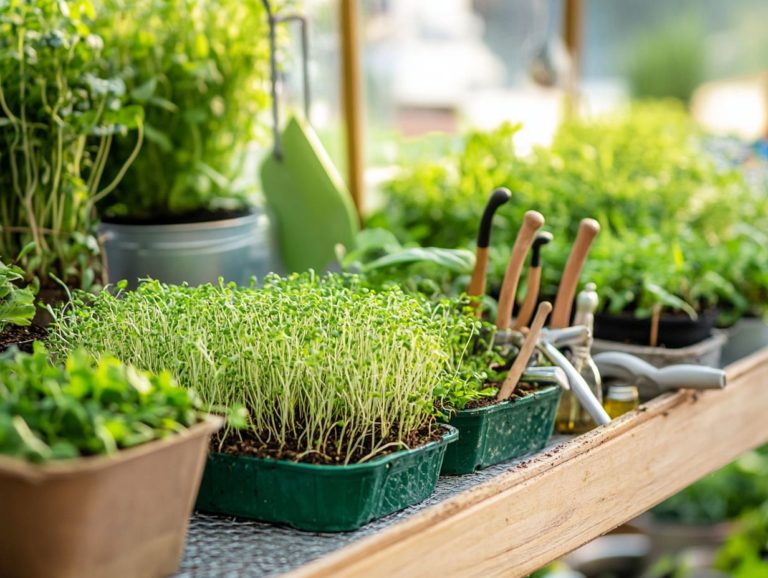Understanding Microgreen Harvest Timing
Microgreens are the exciting new stars of the culinary world! They re celebrated for their vibrant flavors and impressive health benefits. Harvesting them at the right time is crucial to unlocking their full taste and health benefits.
This article explores when to harvest your microgreens. You’ll discover various factors that influence the timing and tips to determine when to pick them.
You ll also find best practices for harvesting microgreens. Rinsing them before storage can enhance their shelf life. Dive into this exploration to elevate your microgreen experience!
Contents
- Key Takeaways:
- Why Harvest Timing Matters
- Factors Affecting Harvest Timing
- How to Determine Harvest Timing
- Best Practices for Harvesting Microgreens
- Maximizing Shelf Life of Harvested Microgreens and Their Health Benefits
- Frequently Asked Questions About Microgreens
- What is microgreen harvest timing based on growth timelines?
- Why is understanding microgreen harvest timing crucial for nutrient density?
- How do I determine when to harvest microgreens based on growth indicators?
- Can I harvest microgreens multiple times for maximum flavor intensity?
- What happens if I harvest microgreens too late for optimal flavor development?
- Can I use my microgreens immediately after harvest to maintain fresh flavor?
Key Takeaways:
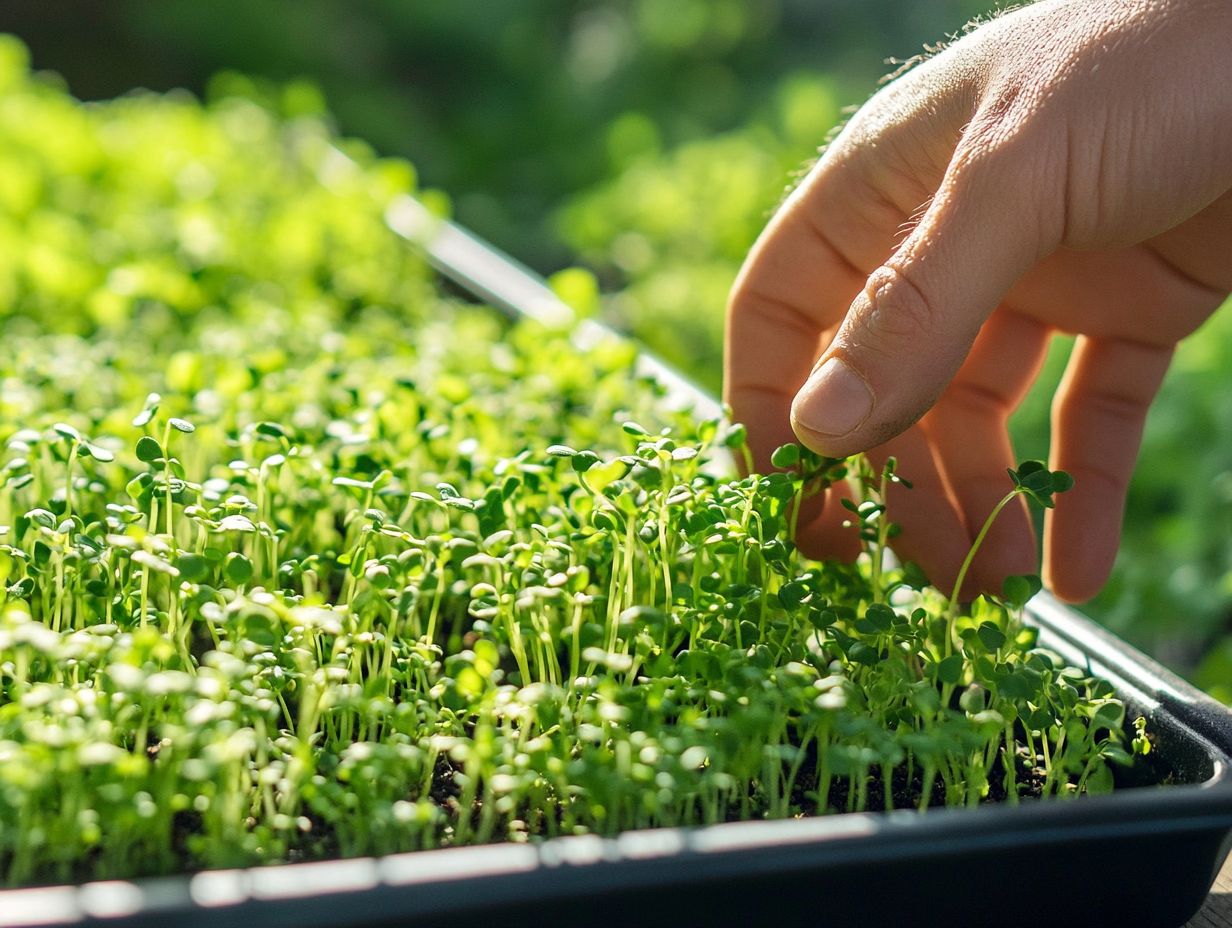
- Harvest microgreens at the right time for the best flavor and nutrition.
- Factors like plant variety and growing conditions affect harvest timing.
- Use visual cues and taste testing to decide when to harvest.
What are Microgreens?
Microgreens, also known as baby greens, are young plants harvested right after they sprout. They offer vibrant colors and unique flavors, perfect for health-conscious individuals and culinary enthusiasts alike.
You can grow these small greens from various seeds like broccoli, arugula, basil, and cilantro. They enhance salads and garnishes, adding flavor and visual appeal.
The growth process for microgreens is surprisingly straightforward, requiring minimal space and just a few weeks from seed to harvest. For example, sunflower shoots and radish microgreens stand out for their robust flavors and rapid growth.
In your culinary endeavors, these tiny greens don t just add a refreshing burst; they also pack a nutrient punch, delivering vitamins A, C, E, and K, along with essential minerals. Their impressive nutrient profile makes microgreens an excellent addition to a variety of dishes, including a delightful microgreen salad.
This provides an effortless way to enhance your meals and maximize your nutritional intake.
Why Harvest Timing Matters
Harvest timing plays a pivotal role in cultivating microgreens, influencing both their flavor profile and nutrient density. By understanding the growth timelines of different varieties, you can ensure optimal flavor and nutrition.
Recognizing the ideal growth indicators for harvest guarantees that each microgreen variety whether it s the bold peppery kick of arugula or the subtle brussels sprout notes found in baby salad mixes delivers its maximum taste and health benefits.
Mastering this timing means you provide consumers with the freshest, most flavorful microgreens available, enhancing their culinary experience and ensuring they enjoy the best flavor and nutrition.
Impact on Flavor and Nutrition
The timing of your microgreens harvest can dramatically influence their flavor and nutritional profile. Picking them at just the right moment enhances their distinct flavors and maximizes their nutrient content. Understanding the flavor contrast between varieties can elevate your culinary creations. For example, when you harvest broccoli microgreens at the perfect stage, you achieve a delightful balance of sweetness and earthiness.
On the other hand, arugula microgreens deliver an intense peppery kick if you pick them just before the true leaves unfold, allowing for a more robust flavor experience. By understanding these nuances, you can craft dishes that are not only nutritious but bursting with flavor.
It s intriguing to see how the same variety of microgreen can offer entirely different taste experiences depending on when you choose to harvest. Take cilantro microgreens, for instance: when you pick them in the seedling phase, they present a mild, fresh flavor. Wait a bit longer, and those same microgreens develop a robust, aromatic quality that can elevate your dishes.
Pea shoots are sweet and crunchy when young. Let them mature for a richer flavor and varied texture. These delightful variations invite you to experiment in the kitchen, tailoring dishes to your preferred flavor intensity and creating a truly dynamic culinary experience that highlights each variety s unique flavor. Start experimenting today!
Factors Affecting Harvest Timing
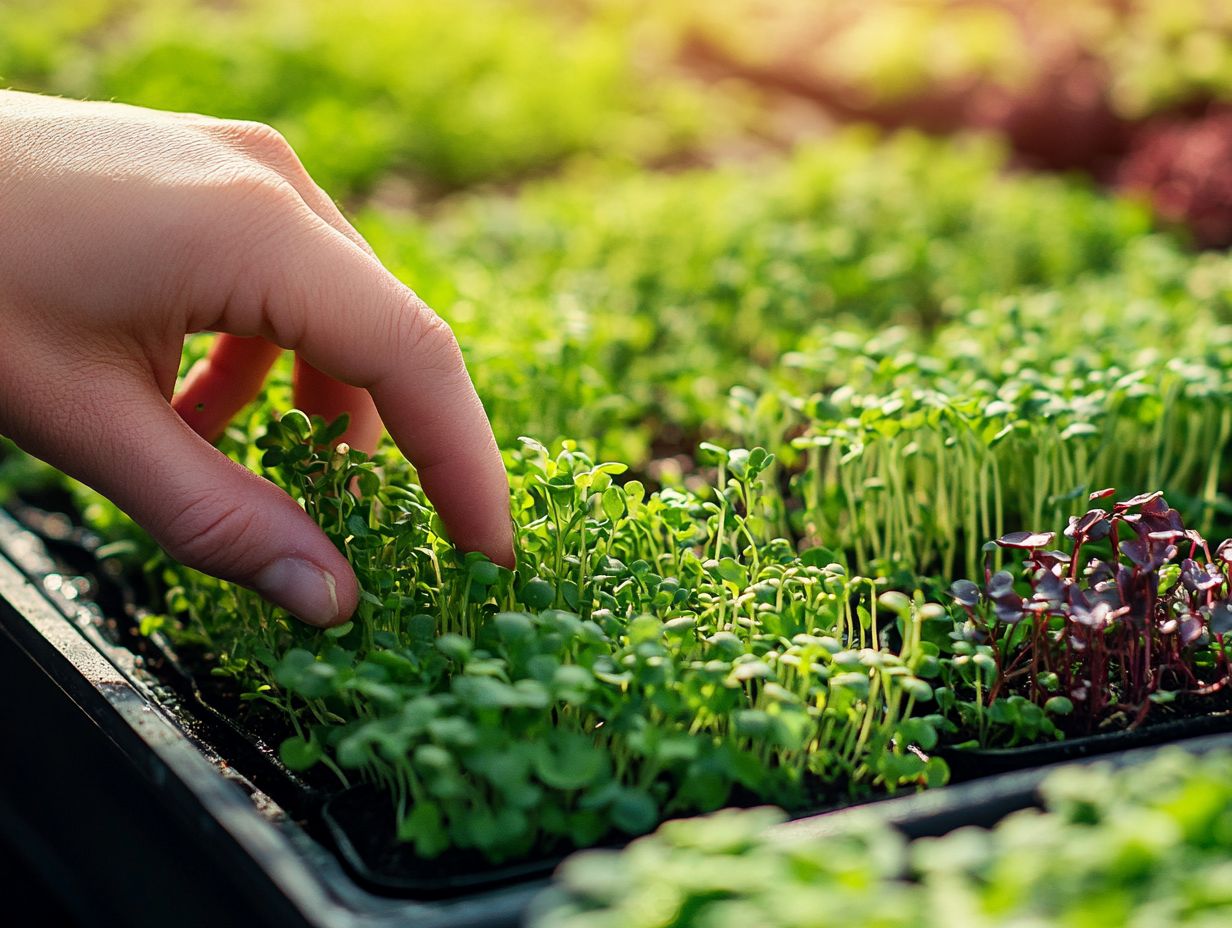
Several factors influence when to harvest your microgreens. These include:
- Plant variety
- Growing conditions
- Germination rates
For example, cilantro microgreens require different care than sunflower shoots, which do well in hydroponic systems or soil mediums. This affects their maturation timelines and taste.
By grasping these nuances, you can refine your harvesting techniques to maximize both flavor and health benefits.
Plant Variety and Growing Conditions
The variety of plants you choose and the growing conditions you provide are crucial for successfully cultivating microgreens. These factors significantly impact flavor, texture, and overall growth rate. Certain varieties, like broccoli, arugula, and cilantro, thrive under different conditions. Some prefer soil mediums, while others flourish in growing plants in water without soil. Understanding these differences is key to growing microgreens successfully.
Take broccoli microgreens, for example. They thrive in nutrient-rich soil, requiring moderate moisture and consistent lighting to enhance their slightly peppery taste, which can be further improved by proper harvesting techniques. Conversely, arugula enjoys cooler temperatures and adapts well to hydroponic methods, delivering a crisp, robust flavor that many chefs find irresistible, especially when harvested at the right time. Cilantro, on the other hand, needs well-draining soil and a touch more warmth too much water can stunt its growth, emphasizing the importance of understanding the growth conditions for successful microgreen cultivation.
The choice between soil and hydroponics doesn t just affect growth speed; it also influences flavor nuances. Soil-based microgreens tend to develop richer tastes due to the organic compounds present in the medium, while hydroponically grown greens may offer milder profiles.
Start your microgreen journey today and experiment with your harvesting techniques to enjoy a flavorful and nutritious experience!
How to Determine Harvest Timing
Deciding when to harvest your microgreens takes a keen eye. Look for growth indicators, visual cues, and taste testing to ensure quality and flavor.
As true leaves emerge, check the vibrant color of the leaves and the overall height of the plants. These factors provide valuable insights into the optimal harvest time.
Taste testing is essential. Sampling at different stages reveals the best flavor intensity, helping you know when your microgreens have reached their peak cooking potential.
Visual Cues and Tasting Techniques
Visual cues and tasting techniques are your best friends when knowing the perfect moment to harvest microgreens. They are vital for understanding the flavor profile and ensuring your greens are fresh.
By observing the vibrant colors and sizes of the green leaves, you can gauge their readiness for harvest. A little taste testing allows you to savor the unique flavor characteristics of each variety think of the bold peppery notes of arugula or the delicate sweetness of basil genovese.
For example, a seasoned chef might suggest looking for a deep green hue in kale microgreens, signaling they are primed for optimal flavor development. Don’t shy away from tasting a small leaf occasionally; it can reveal subtle flavor changes and enhance your understanding of the timing of microgreen harvest and each microgreen’s unique flavor.
Chefs often recount how they determine the right moment to harvest based on that satisfying crunch and an explosion of flavor, emphasizing the importance of timing for the best culinary results.
As a culinary enthusiast, experimenting with different harvest times is exciting. Discover how each variety can transform your dishes!
For instance, you might notice how mustard greens can transition from a mild bite to an assertive spicy kick in just a few days, showcasing the diverse flavor spectrum available with different microgreens. This meticulous attention not only elevates your culinary experience but also fosters a deeper connection to the growing process.
Best Practices for Harvesting Microgreens
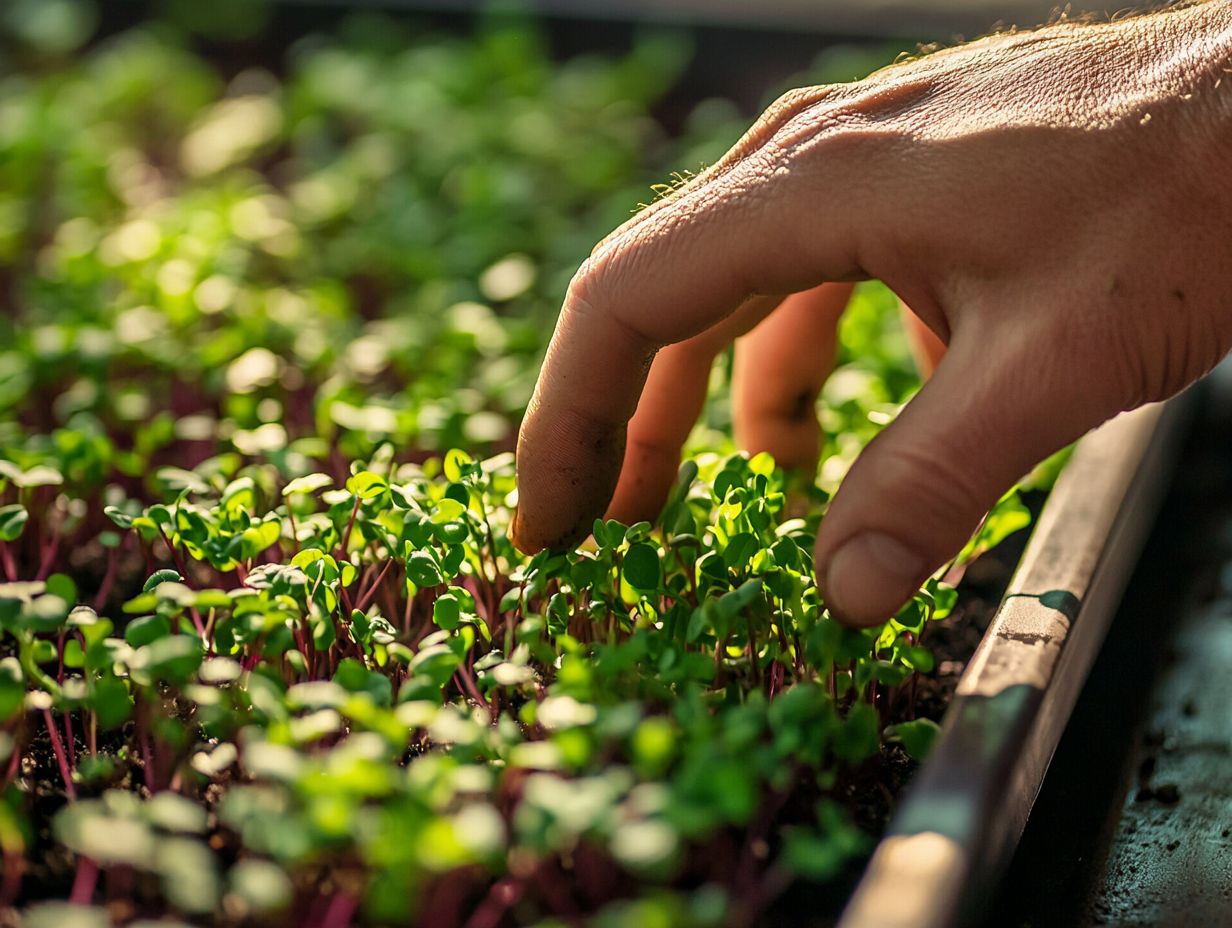
To truly maximize the quality and flavor of your microgreens, it s essential to follow best practices for harvesting and consider proper storage techniques afterward.
Using the right techniques and tools makes all the difference. Opt for clean scissors to ensure a hygienic cutting process. This minimizes damage to the plants and enhances your overall harvesting experience.
By cutting just above the soil line, you can preserve the vibrant color of your microgreens, ensuring they remain visually appealing for your culinary creations.
Proper Techniques and Tools
Using proper techniques and tools for harvesting microgreens is essential to ensure both quality and longevity after harvest. This includes rinsing and storing microgreens properly to maintain freshness. Clean scissors are a must-have in any grower’s toolkit, along with knowledge of effective harvesting techniques to maximize yield.
By cutting at the right height and angle, you promote regrowth and preserve the structure of your microgreens. This leads to a more appealing presentation and enhanced flavor that highlights the unique characteristics of each variety. Familiarizing yourself with understanding the growth patterns of microgreen varieties can elevate your harvesting experience.
Scissors and sharp knives boost efficiency and precision during the harvesting process. Knives facilitate clean cuts, minimizing damage to the remaining plants, while tools like herb harvesters streamline the process for larger batches.
When it s time to harvest, maintain a steady hand and use a gentle sawing motion especially with delicate greens to help prevent bruising. Work in a well-lit area to clearly see your cutting heights, ensuring that you harvest just above the soil line for optimal regrowth without sacrificing quality.
Maximizing Shelf Life of Harvested Microgreens and Their Health Benefits
Maximizing the shelf life of your harvested microgreens is crucial for preserving their flavor and nutritional value. Effective storage and preservation techniques are necessary. By using airtight containers or breathable bags, you retain moisture while preventing wilting, ensuring your microgreens remain fresh and vibrant for an extended period. This is especially important for culinary enthusiasts looking to enhance dishes with a burst of unique flavor.
Implementing these optimal storage methods allows microgreens to maintain their health benefits while elevating the culinary experience with their flavors intact, enhancing the taste testing journey.
Storage and Preservation Methods for Microgreens
Storage and preservation methods for microgreens are crucial in maintaining their fresh flavor and health benefits after harvest, particularly for popular microgreen varieties. By using various techniques, you can significantly enhance the longevity and taste of these nutrient-packed greens.
For instance, placing your harvested microgreens in a breathable container lined with damp paper towels keeps moisture levels in check and minimizes the risk of wilting. Refrigeration at optimal temperatures can extend their freshness, especially for broccoli microgreens and cilantro microgreens. Be mindful to avoid moisture buildup in the fridge, as this can lead to spoilage. Using airtight packaging ensures that your herbs remain crisp and protected from environmental factors.
To maximize the benefits of microgreens, consume them within a week of harvest; this guarantees superior flavor and nutrient retention. Look for signs of growth and visual cues to determine the right time for consumption.
Exploring various storage options can elevate your culinary experience, making each dish fresher and healthier, particularly when incorporating baby salad and baby greens into your meals.
Frequently Asked Questions About Microgreens
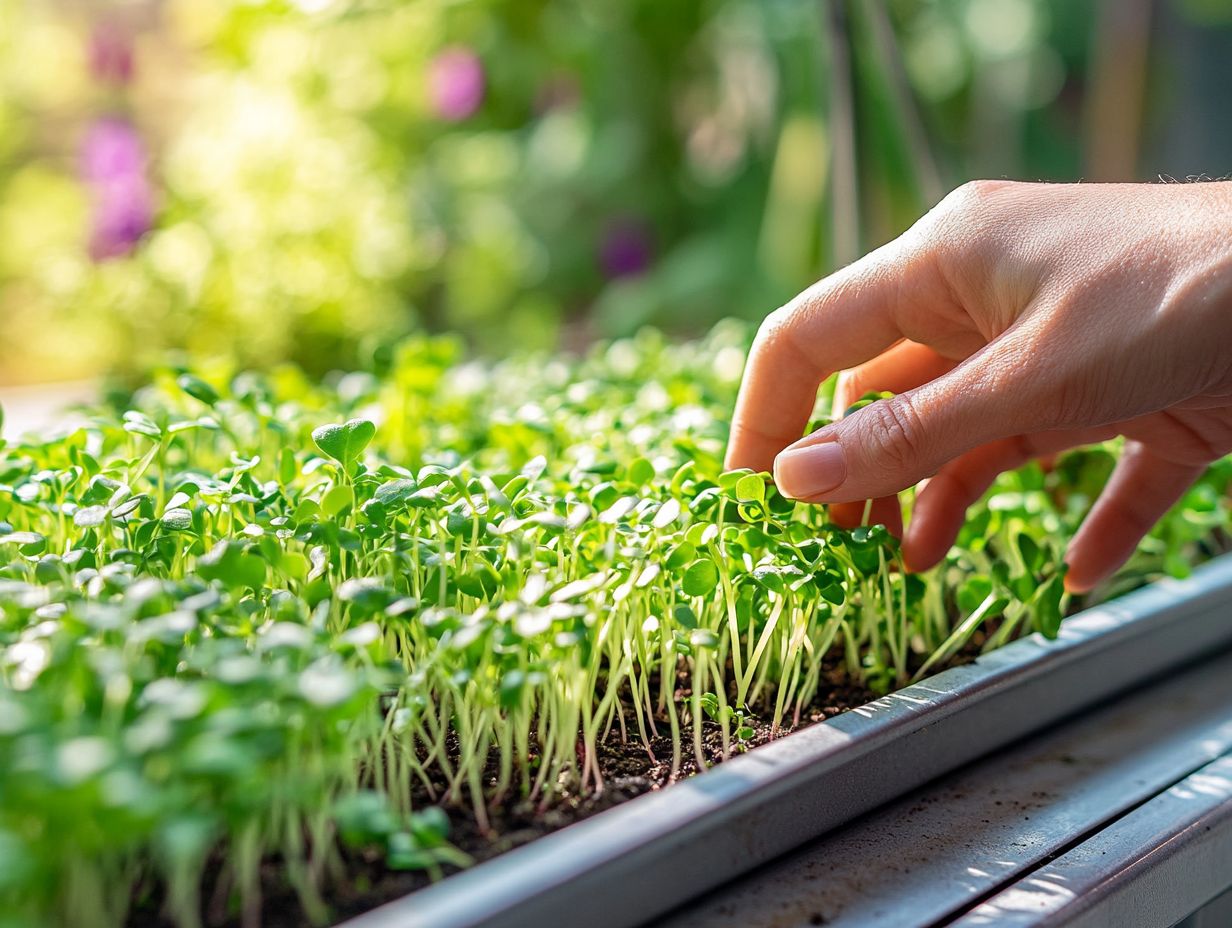
What is microgreen harvest timing based on growth timelines?
Microgreen harvest timing refers to determining the optimal time to harvest microgreens, which are young, edible plants harvested when they have just developed their first set of true leaves the leaves that grow after the initial seed leaves. It s important to harvest microgreens at the right time to ensure the best flavor, nutrition, and appearance.
In summary, proper harvesting and storage techniques are essential for enhancing the flavor and health benefits of microgreens. Remember to use the right tools, store them effectively, and consume them promptly for the best culinary experience!
Why is understanding microgreen harvest timing crucial for nutrient density?
Understanding microgreen harvest timing is essential. It greatly affects the taste, nutritional value, and appearance of microgreens.
Harvesting too early or too late can lead to bitter or wilted microgreens. Harvest at the right moment to enjoy the best flavor and ensure their nutrient content is at its peak.
How do I determine when to harvest microgreens based on growth indicators?
To know when to harvest microgreens, observe the plants closely. Look for specific signs like the emergence of their first real leaves and the color of their stems and leaves.
Each type of microgreen may have different indicators for harvest timing, such as how quickly seeds sprout (germination rate) and the cotyledon stage.
Can I harvest microgreens multiple times for maximum flavor intensity?
Yes! You can harvest microgreens multiple times by cutting them just above the soil level with clean scissors or a sharp knife. The microgreens will keep growing after the initial harvest.
However, flavor and nutrition may decrease with each subsequent harvest, particularly for varieties like arugula and sunflower shoots.
What happens if I harvest microgreens too late for optimal flavor development?
If you harvest microgreens too late, they may become wilted or bitter and lose their vibrant color. This can affect their nutritional value and taste.
Pay close attention to the signs of harvest timing to avoid compromising the flavor profile.
Can I use my microgreens immediately after harvest to maintain fresh flavor?
Absolutely! Use your microgreens right after harvest, as they are best consumed fresh. Their flavor and nutritional value may decrease over time.
If you can t use them immediately, no worries! Store them in the refrigerator for a few days in a sealed container lined with paper towels to keep them fresh.
Why wait? Start your microgreen garden today for fresh flavor and nutrition!

